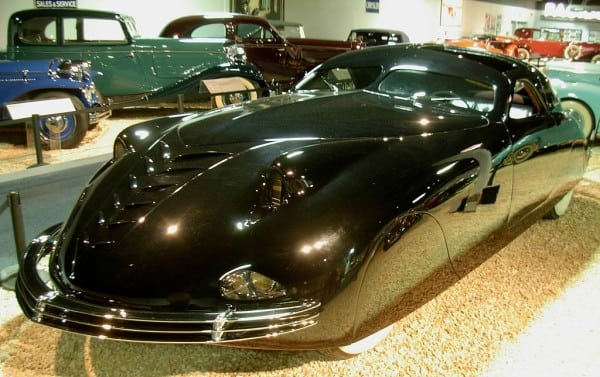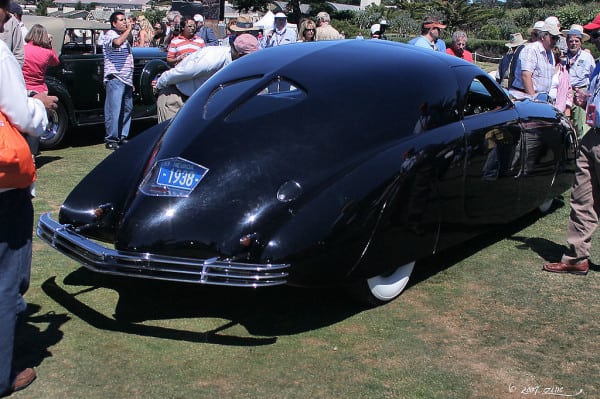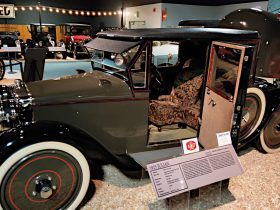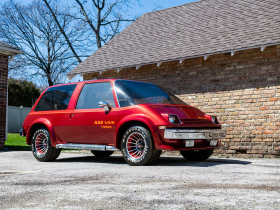The Phantom Corsair is a prototype that was built to be production-ready as a luxury coupe in 1938. It was designed by Rust Heinz (yes, those Heinz’s) and built by Maurice Schwartz of the Bohman & Schwartz coachbuilding company in Pasadena, California.
This unusual car, which looks like it came straight out of a Dick Tracy or Shadow comic strip, was ahead of its time in many ways, with features that wouldn’t become commonplace until just a few years ago and a timeless, unusual design that fascinates even today.
When it was posted to our Facebook as a Car of the Day, the Phantom Corsair became immediately popular, so it seemed appropriate to talk about the car.
The Design
The Phantom Corsair was built on top of a Cord 810 chassis, modified to accommodate the Corsair’s longer, wider bodywork. The car is an impressive 237 inches long and 76.5 inches wide, standing only 57 inches tall at its roof apex. It seats six, has fully-enclosed wheels, and flush fenders.
The car is very heavy, despite its extensive use of aluminum throughout the body. It weighs in at 4,600 pounds, but the powerful Lycoming V-8 it has under the hood produces 190 bhp and can propel the car to 115 miles per hour.
It rides on the Cord’s innovative independent suspension and adjustable shocks and uses its groundbreaking electrically-activated four-speed automatic gearbox.
The interior layout is unusual, seating four up front (including the driver) and two in the back. The back seat is stunted down to only two thanks to the large beverage bars built into the rear.
The low-slung, coupe look the 1938 Phantom Corsair sports was, at the time, a popular idea for sports cars and is today one of the most-loved retro looks a car can achieve. Despite its looks, though, aerodynamics on the Phantom Corsair are only marginal by today’s standards, though they were cutting-edge in 1938. The shape is actually counter-productive for airflow, allowing a lot of lift underneath the car due to the body’s “clamshell” shape (a problem common to vehicles of this shape, such as the early Volkswagen Beetle).
Innovations
Most of the innovations in the 1938 Phantom Corsair were inside the cockpit, but on the exterior, most will note the lack of door handles to open the car with. These were integrated push buttons that sent an electric signal to the latch, opening it. They could also be opened from the instrument panel on the dashboard.
Inside, the car features a lot of other electronic innovations. A compass and altimeter are prominent on the instrument cluster and a console above the windshield has indicators to let the driver know that a door is open, the radio is on, the headlights are on, etc. This would not become standard in vehicles for many years hence.
The unusual body, while shaped uniquely, incorporated some steel and aluminum melding and alloys that were cutting-edge for the time, but that eventually became generally standard by the 1990s. The electrically-operated automatic gearbox was also unusual for the time, but is now seeing a revival of sorts with modern electronics.
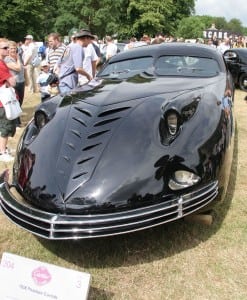 The Phantom Corsair was planned for production, with Rust Heinz planning to put it into limited production in 1939 and sell it at about $12,500 (equivalent to nearly $200,000 today). An untimely car accident in July 1939 killed Heinz, however, putting an end to production investment.
The Phantom Corsair was planned for production, with Rust Heinz planning to put it into limited production in 1939 and sell it at about $12,500 (equivalent to nearly $200,000 today). An untimely car accident in July 1939 killed Heinz, however, putting an end to production investment.
Where Is It Now?
The 1938 Phantom Corsair is a one-of-a-kind prototype now owned by the National Automobile Museum in Reno, Nevada. Part of the Harrah Collection, it is shown year round at the museum and makes occasional excursions as a still-running prototype to various automotive shows. Most of the photos here are from Wikimedia and were taken at those shows, including the 2006 Goodwood Festival of Speed and the 2007 Pebble Beach Concours d’Elegance.




